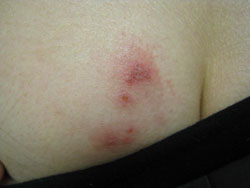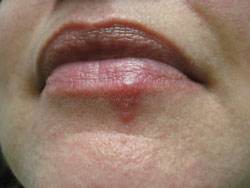The Toronto Dermatology Centre is one of the top places in Canada to manage your skin infections such as herpes simplex virus (“cold sore” virus). Our staff of outstanding dermatologists offer both a comprehensive assessment and diagnosis of your skin, and also discuss all the treatment options (creams, pills, prevention), including episodic and preventative therapy.
 The herpes simplex virus (HSV) causes blisters and sores around the mouth, nose, genitals, and buttocks, but they may occur almost anywhere on the skin. HSV infections can be very annoying because they may reappear periodically.
The herpes simplex virus (HSV) causes blisters and sores around the mouth, nose, genitals, and buttocks, but they may occur almost anywhere on the skin. HSV infections can be very annoying because they may reappear periodically.
The sores may be painful and unsightly. There are two types of HSV – Type 1 & Type 2.
Herpes Simplex Virus Type 1
Often referred to as fever blisters or cold sores, HSV Type 1 infections are small fluid-filled blisters that mostly occur on the face. Less frequently, they can occur in the genital area. Type 1 may also develop in wounds on the skin.
There are two kinds of infections – primary and recurrent. Although most people get infected when exposed to the virus, only 10% will actually develop sores. The sores of a primary infection appear 2-20 days after contact with an infected person and can last 7-10 days. Before the blisters appear, the skin may itch, sting, burn, or tingle. The blisters can break, allowing the fluid inside the blisters to ooze and crust. Eventually, crusts fall off, leaving slightly red healing skin.
The sores from the primary infection heal completely and rarely leave a scar. However, the virus that caused the infection remains in the body. It moves to nerve cells where it remains in a resting state. People may then have a recurrence either in the same location as the first infection or in a nearby site. The infection may recur every few weeks or not at all.
Recurrentinfections tend to be mild. They can be set off by a variety of factors including fever, sun exposure, a menstrual period, trauma (including surgery), or nothing at all.
Herpes Simplex Virus Type 2
Infection with HSV Type 2 usually results in sores on the buttocks, penis, vagina, or cervix, 2-20 days after contact with an infected person. Sexual intercourse is the most frequent means of getting the infection. Both primary and repeat attacks can cause problems including: a minor rash or itching, painful sores, fever, aching muscles, and a burning sensation with urination.
As with Type 1, sites and frequency of repeated bouts vary. The initial episode can be so mild that a person does not realize that he or she has an infection. Years later, when there is a recurrence of HSV, it may be mistaken for an initial attack, leading to unfair accusations about the source of infection.
 How Do You Get Herpes?
How Do You Get Herpes?
Most people get Type 1 infections, which cause cold sores, during infancy or childhood. They usually get it from close contact with family members or friends who carry the virus. It can be transmitted by kissing, sharing eating utensils, or by sharing towels. The sores most commonly affect the lips, mouth, nose, chin, or cheeks and occur shortly after exposure.
Most people get Type 2 infections, which cause genital sores, following sexual contact with an infected person. The virus affects up to 20% of all sexually active adults. The lesions of both types of herpes simplex, can be spread by touching an unaffected part of the body immediately after touching a herpes lesion.
How are the HSV Infections Diagnosed?
The appearance of HSV is often typical and no testing is needed to confirm the diagnosis. If diagnosis is uncertain, a swab from the infected skin for culture or smear may be taken and sent to the laboratory for analysis. Laboratory tests include special microscopic examinations and blood tests for antibodies.
How are Herpes Infections Treated?
Oral anti-viral medications such as valacyclovir (Valtrex), famciclovir (Famvir), and acyclovir (Zovirax) have been developed to effectively treat herpes infections. These medications can be used to treat an outbreak (“episodic therapy”) or can be used constantly to suppress herpes recurrences, reduce outbreaks, and spreading by viral shedding.
How Do You Prevent Transmission?
There is no vaccine that prevents this contagious disease and unfortunately no cure yet. If tingling, burning, itching, or tenderness occurs in an area of the body where there is a herpes infection, the area should be kept away from other people. With mouth herpes, one should avoid kissing, sharing cups, or lip balms. For persons with genital herpes, this means avoiding sexual relations, including oral/genital contact during the period of symptoms or active lesions. Condoms can help prevent transmission of genital herpes between sexual partners and should always be used. However, they will not protect against the virus that may be living on nearby genital skin that is not covered by the condom.
Can Herpes be Spread if There is no Visible Sore?
Yes. Most herpes is transmitted in the absence of lesions! Over 80% of all genital herpes is transmitted when there are no lesions and no symptoms. This phenomenon is known as asymptomatic viral shedding. People who never recall having had an outbreak of genital herpes can have positive blood tests for antibodies to herpes and can shed the virus. Taking antiviral medications daily reduces both viral shedding and disease transmission.
Other Serious Implications of HSV
HSV can be life-threatening to immunosupressed patients. HSV infection of the eye can lead to herpes keratitis, characterized by pain, light sensitivity, and discharge. Without prompt treatment, scarring of the eye may result. Pregnant women should avoid sexual contact with a partner who has active genital herpes.. A newborn can be infected at the time of childbirth, by the mother or healthcare worker who has active lesions on the lips or hands, and from family members and friends with active HSV.
